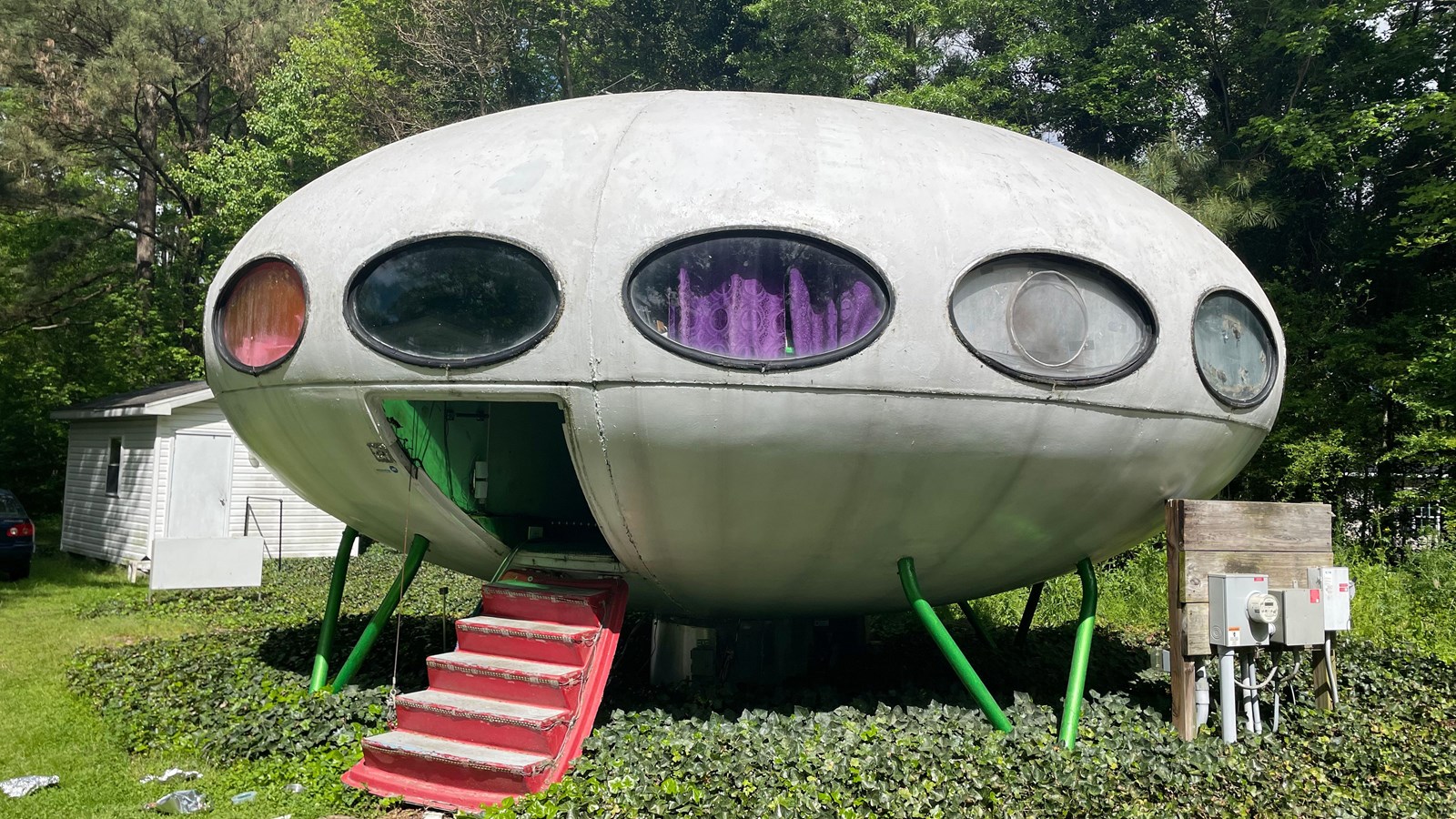Last updated: January 5, 2024
Place
Vincelette Futuro House

Photograph courtesy of Delaware SHPO staff
Quick Facts
Location:
Houston, Delaware
Significance:
Architecture, Social History
Designation:
Listed in the National Register – Reference number 100009680
OPEN TO PUBLIC:
No
MANAGED BY:
Private
“Flying saucers you can live in” - advertisement from the Futuro Corporation
The Vincelette Futuro House, located in the town of Houston, Delaware, was listed in the National Register of Historic Places in 2023.
Matti Suuronen, the renowned midtwentieth-century Finnish architect, achieved the house’s distinctive shape through a manufacturing process that molded plastic into the Futuro’s elegant curves. The structure’s shell consists of a central fiberglass and polyester resin layer that sandwiches a core of polyurethane foam between an outer and inner layer of polyester plastic. In the eastern United States, Futuros were manufactured in an Atlantic City, New Jersey factory, delivered by truck in sections, and assembled on-site. Concrete piers form a foundation for the metal frame that cradles the Futuro 24 inches above the ground. The building measures 26 feet in diameter and 13 feet high. The weight of the original prototype was 5511 lbs. At 500 square feet, the Futuro features a compact design that includes a central living area as well as a wedge-shaped bedroom, kitchen, and bathroom. The Vincelette Futuro has remained at this location since June 7, 1977.
In this period of significance (1969-1977), Americans exhibited intense interest in the space race and moon landing. Their interests are evident in the popular culture of the era, including literature, film, clothing, décor, and architecture. The distinctive futuristic style and form of the Futuro captivated audiences in the United States when it was first displayed in 1969. Almost instantly, the Futuros amassed an American following. Its popularity was largely due to Americans’ fascination with space, Cold War-era science fiction, and dramatic developments in American aerospace technology. The Futuro held particular appeal in Delaware because ILC Dover, a division of the International Latex Corporation, later known as Playtex, engineered and produced the first space suits, including those worn by Astronaut Neil Armstrong and others. In addition, the DuPont Company provided much of the research and several key products required for the suits and other components of the Apollo Program. Furthermore, the Futuro tapped into the era’s passion for mobility in a new way. The Futuro was exotic, sleek, modern, and movable. It became a cultural icon and symbol of a new future that promised Americans a kind of freedom in an era of insecurity.
The ideas embodied by the Futuro have captivated people around the globe. Their elegant shape, remarkable versatility, and the dream of mobility have captured imaginations and evoked a sense of excitement and hope for generations. Americans in particular have had a romance with their spectacle. Although mass production and easy relocation proved untenable at the time, they remain culturally relevant.
On March 1, 2022, US Lighting Group Incorporated announced the formation of a new company, Futuro Corporation, LLC.
The Vincelette Futuro House, located in the town of Houston, Delaware, was listed in the National Register of Historic Places in 2023.
Matti Suuronen, the renowned midtwentieth-century Finnish architect, achieved the house’s distinctive shape through a manufacturing process that molded plastic into the Futuro’s elegant curves. The structure’s shell consists of a central fiberglass and polyester resin layer that sandwiches a core of polyurethane foam between an outer and inner layer of polyester plastic. In the eastern United States, Futuros were manufactured in an Atlantic City, New Jersey factory, delivered by truck in sections, and assembled on-site. Concrete piers form a foundation for the metal frame that cradles the Futuro 24 inches above the ground. The building measures 26 feet in diameter and 13 feet high. The weight of the original prototype was 5511 lbs. At 500 square feet, the Futuro features a compact design that includes a central living area as well as a wedge-shaped bedroom, kitchen, and bathroom. The Vincelette Futuro has remained at this location since June 7, 1977.
In this period of significance (1969-1977), Americans exhibited intense interest in the space race and moon landing. Their interests are evident in the popular culture of the era, including literature, film, clothing, décor, and architecture. The distinctive futuristic style and form of the Futuro captivated audiences in the United States when it was first displayed in 1969. Almost instantly, the Futuros amassed an American following. Its popularity was largely due to Americans’ fascination with space, Cold War-era science fiction, and dramatic developments in American aerospace technology. The Futuro held particular appeal in Delaware because ILC Dover, a division of the International Latex Corporation, later known as Playtex, engineered and produced the first space suits, including those worn by Astronaut Neil Armstrong and others. In addition, the DuPont Company provided much of the research and several key products required for the suits and other components of the Apollo Program. Furthermore, the Futuro tapped into the era’s passion for mobility in a new way. The Futuro was exotic, sleek, modern, and movable. It became a cultural icon and symbol of a new future that promised Americans a kind of freedom in an era of insecurity.
The ideas embodied by the Futuro have captivated people around the globe. Their elegant shape, remarkable versatility, and the dream of mobility have captured imaginations and evoked a sense of excitement and hope for generations. Americans in particular have had a romance with their spectacle. Although mass production and easy relocation proved untenable at the time, they remain culturally relevant.
On March 1, 2022, US Lighting Group Incorporated announced the formation of a new company, Futuro Corporation, LLC.
